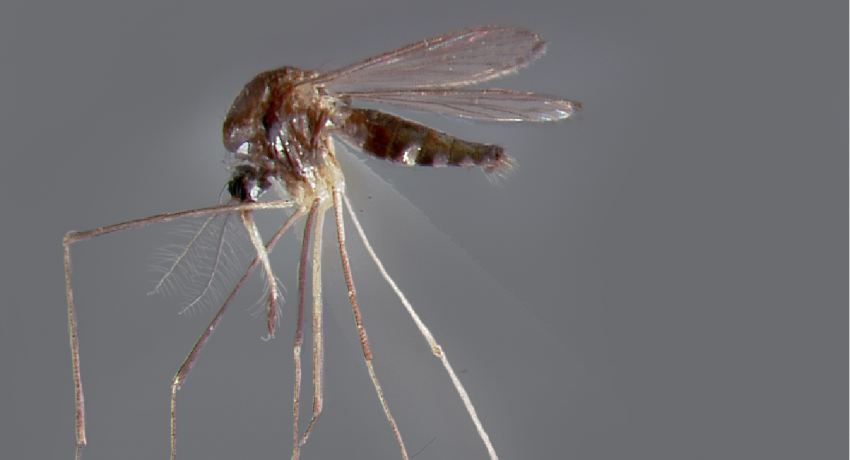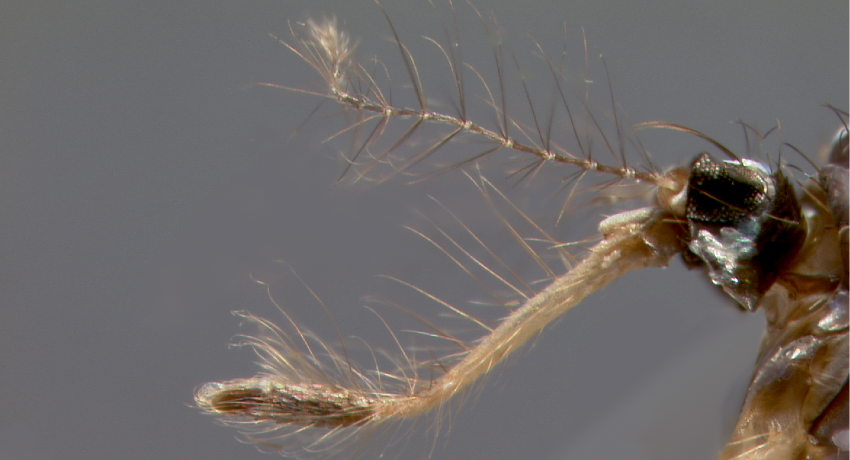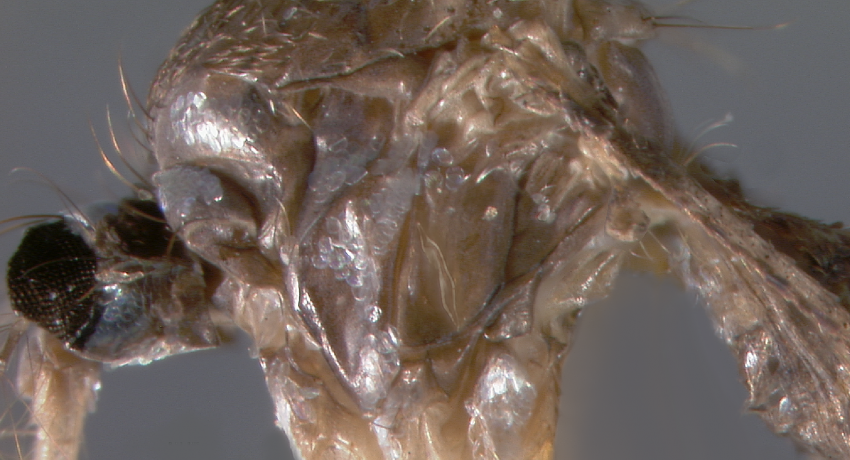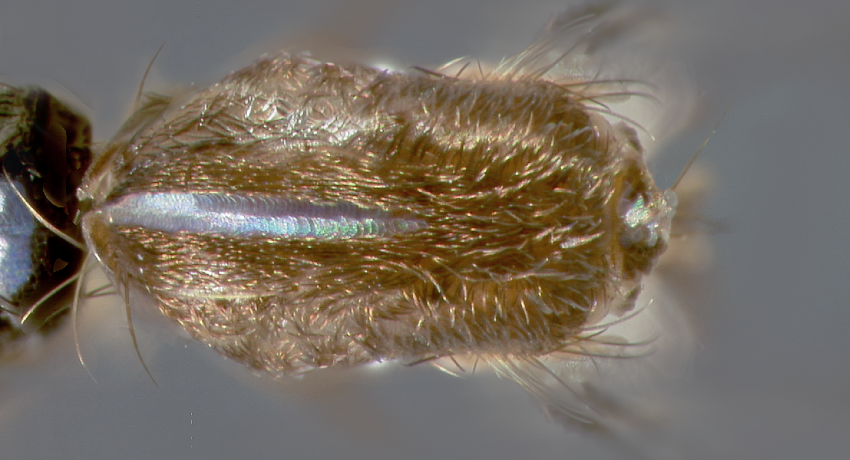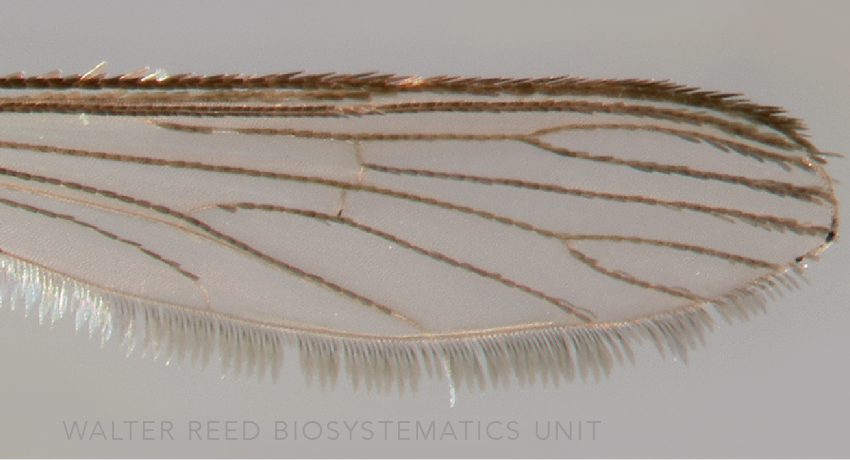AFROTROPICS, ORIENTAL AND AUSTRALASIAN REGIONS
Generic abbreviation: Ml.
Type species: Malaya genurostris Leicester
Etymology: Malaya [Malaysia]
The Sabethine genus Malaya comprises 12 tiny species: Ml. farquharsoni (Edwards), Ml. fraseri (Edwards), Ml. genurostris Leicester, Ml. incomptas Ramalingam & Pillai, Ml. jacobsoni (Edwards), Ml. leei (Wharton), Ml. marceli (Mattingly), Ml. moucheti (Hamon & Adam), Ml. solomonis (Wharton), Ml. splendens (de Meijere), Ml. taeniarostris (Theobald), and Ml. trichorostris (Theobald).
Adults of the genus Malaya are small, very distinctive mosquitoes. Malaya species bear a line of silvery or white scales down the center of the scutum—Kimia and Topomyia—but are distinguished from these and all other genera by their distinctive hairy clubbed proboscis.
DIAGNOSTIC CHARACTERS (Click photos to view; mouse over and click large photo to zoom in.)
ADULT (illustrated): Head: Modified proboscis with many erect setae, upturned and apically swollen. Thorax: Scutum usually with median longitudinal white or silver stripe. Wings: Upper calypter bare, alula fringed; vein 1A turns and terminates level with base of mediocubital crossvein
LARVA (not illustrated): Head: Maxillary palpus fused with maxillary body; occipital foramen slit-like. Thorax: Seta 13-P absent. Terminal segments: Siphon with two or more subdorsal setae and assorted ventral or subventral setae; seta 4-X single; comb with comb scales fringed and in an irregular patch.
TAXONOMIC KEYS
Wharton 1947
Lee et al. 1988b
Service 1990
Rattanarithikul & Harrison et al. 2005
![]()
WRBU – Genera – Global – Larva
![]()
WRBU – Genera – Afrotropical – Adult
![]()
WRBU – Genera – Afrotropical – Larva
![]()
WRBU – Genera – Australasia – Adult
![]()
WRBU – Genera – Australasia – Larva
![]()
WRBU – Genera – IndoMalaya – Adult
![]()
WRBU – Genera – IndoMalaya – Larva
![]()
WRBU – Genera – Oriental – Adult
![]()
WRBU – Genera – Oriental – Larva
![]()
WRBU – Genera – Eastern Palearctic – Adult
![]()
WRBU – Genera – Eastern Palearctic – Larva
Exemplar DNA sequences
Malaya genurostris COI: AY917204, EU259293
BIONOMICS
Immatures
Malaya immatures are often found in elevated water-filled plant cavities including tree-holes, pitcher plants, leaf axils [Musa, AIIocasia, Colocasia, Pandanus], and in water collections in arboreal ant nests. Occasionally they have been reported in bamboo stumps and pineapple and taro leaf axils, closer to ground level.
Adults
Due to extensive modifications of their mouthparts, the proboscis of Malaya species are incapable of piercing skin or blood feeding. Malaya species have evolved to feed entirely on the regurgitation of ants. Adult Malaya seek and mount ants in the daytime, drumming on the ants maxillary palps with their club-like proboscis, inducing it to regurgitate a drop of sugary nectar, which is rapidly sucked up by the mosquito. Although this appears not to be a symbiotic association, the ants are not harmed in the process.
*Associated pathogens: This list reports bacteria, viruses, and parasites recovered from, or experimentally passed through this species, and does not imply field vector status.
IMPORTANT REFERENCES (full citations below)
Leicester 1908: 258 (as genus)
de Meijere 1909 (as Harpagomyia)
Theobald 1909b (as Grahamia)
Barraud 1934 (taxonomy, bionomics, distribution; south Asia [as genus Harpagomyia])
Wharton 1947 (keys; Australasian & Oriental regions)
Thurman 1959b (taxonomy, Thailand)
Belkin 1962 (taxonomy, bionomics; South Pacific)
Tanaka et al. 1979 (taxonomy, bionomics; Japan)
Lee et al. 1988b (keys, bionomics; Australasian Region)
Service 1990 (keys, bionomics; Afrotropical Region)
Harbach & Peyton 1993 (comparative morphology of larval maxillae)
Judd 1996 (phylogeny)
Harbach & Kitching 1998 (phylogeny)
Harbach & Peyton 2000 (phylogeny)
Rattanarithikul & Harrison et al. 2005 (F, L; keys, biononomics; Thailand)
Rattanarithikul et al. 2007 (taxonomy, bionomics; Thailand)
Harbach et al. 2007b (phylogeny)
VALID SUBGENERA
None
CURRENT GENERIC SYNONYMS
syn. Grahamia Theobald 1909b: 23 (May) (as genus). Type species: Grahamia trichorostris Theobald.
syn. Harpagomyia de Meijere 1909: 165 (Dec.) (as genus). Type species: Harpagomyia splendens de Meijere.
CITED REFERENCES
Barraud, P. J. (1934). The fauna of British India, including Ceylon and Burma. Diptera. Vol. 5. Family Culicidae, tribes Megarhinini and Culicini (Vol. 5). London: Taylor and Francis.
Belkin, J.N. (1962). The mosquitoes of the South Pacific (Diptera, Culicidae) (Vols. 1 &2). Berkeley, California: University of California Press.
de Meijere, J.C.H. (1909). Drei Myrmecophile Dipteren aus Java. Tijdschrift voor Entomologie, 52, 165–174.
Harbach, R.E. & Kitching, I.J. (1998). Phylogeny and classification of the Culicidae (Diptera). Systematic Entomology, 23(4), 327–370.
Harbach, R.E., & Peyton, E.L. (1993). Morphology and evolution of the larval maxilla and its importance in the classification of the Sabethini (Diptera: Culicidae). Mosquito Systematics, 25(1), 1–16.
Harbach, R.E., & Peyton, E.L. (2000). Systematics of Onirion, a new genus of Sabethini (Diptera: Culicidae) from the Neotropical region. Bulletin of the Natural History Museum London (Entomology), 69, 115–159.
Harbach, R.E., Huong, V.E., & Kitching, I.J. (2007b). Systematics of Kimia, a new genus of Sabethini (Diptera: Culicidae) in the Oriental Region. Proceedings of the Entomological Society of Washington, 109(1), 102–120.
Judd, D.J. (1996). Review of the systematics and phylogenetic relationships of the Sabethini (Diptera: Culicidae). Systematic Entomology, 21(2), 129–150.
Lee, D.J., Hicks, M.M., Debenham, M.L., Griffiths, M., Bryan, J.H., & Marks, E.N. (1988b). The Culicidae of the Australasian region. Volume 9. Commonwealth Department of Health, School of Public Health and Tropical Medicine Monograph Series, 2.
Leicester, G.F. (1908). The Culicidae of Malaya. Studies from the Institute for Medical Research, Federated Malay States, 3(3), 18–261.
Rattanarithikul, R., Harbach, R.E., Harrison, B.A., Panthusiri, P., & Coleman, R.E. (2007). Illustrated keys to the mosquitoes of Thailand. V. Genera Orthopodomyia, Kimia, Malay, Topomyia Tripteroides, and Toxorhynchites. Southeast Asian Journal of Tropical Medicine and Public Health, 38 (Supplement 2), 1–65.
Rattanarithikul, R., Harrison, B.A., Panthusiri, P., & Coleman, R.E. (2005). Illustrated keys to the mosquitoes of Thailand. I. Background; geographic distribution; lists of genera, subgenera, and species; and a key to the genera. Southeast Asian Journal of Tropical Medicine and Public Health, 36(1), 1–80.
Service, M.W. (1990). Handbook to the Afrotropical toxorhynchitine and culicine mosquitoes, excepting Aedes and Culex. British Museum (Natural History).
Tanaka, K., Mizusawa, K., & Saugstad, E.S. (1979). A revision of the adult and larval mosquitoes of Japan (including the Ryukyu Archipelago and Ogasawara Islands) and Korea (Diptera: Culicidae). Contributions of the American Entomological Institute, 16, 1–987.
Theobald, F.V. (1909b). Description of the new mosquitoes collected by Dr. Graham in Ashanti. Colonial Office Report, misc Ser 237.
Thurman, E.B. (1959b). A contribution to a revision of the Culicidae of northern Thailand. Bulletin of the University of Maryland Agriculture Experimental Station A, 100, 1–177.
Wharton, R. H. (1947). Notes on Australian mosquitoes (Diptera, Culicidae). VII. The genus Harpagomyia. Proceedings of the Linnean Society of New South Wales, 72, 58–68.
CITE THIS PAGE
Walter Reed Biosystematics Unit (Year). Malaya genus page. Walter Reed Biosystematics Unit Website, http://wrbu.si.edu/vectorspecies/genera/malaya, accessed on [date (e.g. 03 February 2020) when you last viewed the site].

